 PDF Annotation (Notes & Highlighting)
PDF Annotation (Notes & Highlighting)
Updated 2018-10-08
Links to Related Pages
- PDF Link Navigation
- 3-Line Material on the iPad
- 3-Line Material on the iPhone and the iPod touch
- Printing Extra Large Print 3-Line Material
- Printing Selected Pages From a PDF
Contents
- Introduction
- PDF Annotation in Adobe Reader
- PDF Annotation in Mac OS X’s Preview
- PDF Annotation in PDF-XChange Viewer & Foxit Reader
- PDF Annotation in iPhone, iPod touch, and iPad Apps
Introduction
It appears that more and more, the 3-line and pinyin PDF files will be used on computers, including mobile devices such as the iPhone, the iPod touch, and the iPad, rather than printed out on paper. So, to take advantage of the computing power available on such devices, bookmarks and links have been added to some of these PDF files to make it much more quick and convenient to find the material one is looking for while using them. PDF bookmarks and links are especially helpful on iPhone-sized mobile devices, since they remove the need for a lot of the tedious manual scrolling that would otherwise be required because of the relatively small screens on such devices. (See the PDF Link Navigation page for more information, including a video screen recording of the PDF bookmarks and links in action.)
Annotation, or the ability to add notes, highlighting, and other markings, is another feature of PDF files that many will want to take advantage of as well. Annotation is like margin notes, underlining, highlighting, etc. on paper publications.
Here are a couple of examples of annotations made in Adobe Reader 9, one with the Sticky Note tool and one with the Highlight Text tool:
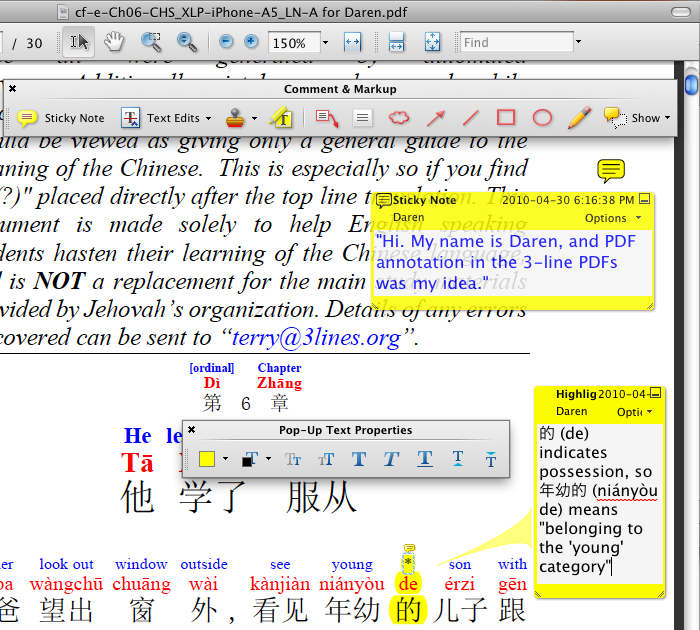
Some annotations like the ones shown above have popups that can be toggled to appear or not to appear. Also, note that Chinese characters and pinyin vowels can be included in annotation text.
On a personal scale, PDF bookmarks, links, and annotation and other features like searchability should help make PDF files sometimes even more convenient to use than their paper equivalents for reference, personal study, etc. This is especially so if one has one of the mobile devices that are now becoming common, like the iPad. Millions of people are acquiring such devices for a variety of reasons, and some are finding that with the aid of such a device, they engage with digital publications (like PDF files) more often, more deeply, and more productively than they do with their paper counterparts.
Looking at the bigger picture, increased use of PDF files (and any other future types of digital documents) instead of their paper counterparts ought to save printing, materials, storage, and distribution costs on a worldwide scale for the organization, and it also ought to help make more of the publications more easily available more of the time, sooner, and in more places around the world.
The 3-line, etc. PDF files with “LN-A” (“Link Navigation-Annotation”) in their names have been enriched and fortified with PDF bookmarks and links, and they have also had annotation enabled for when they are opened in versions of Adobe Reader older than Adobe Reader X. (Adobe Reader is probably the most commonly used program for viewing PDF files, but versions of it older than version X could only add annotations to PDF files that were specifically enabled for annotation in Adobe Reader.)
So far, none of the 3-line PDF files without “LN-A” in their names have been so enabled, and also, none of the official pinyin PDF files available for download from jw.org have been so enabled either. Thus, versions of Adobe Reader older than Adobe Reader X are not able to add annotation to these files.
Happily, as described below, some programs will allow annotation of even PDF files that have not been specifically enabled for commenting, as long as the security settings for those files allow it. These programs include version X or newer of Adobe Reader, as well as some free alternatives to Adobe Reader.
Currently, the security settings of non-LN-A 3-line and pinyin PDF files, including PDF files from jw.org, do allow annotation of even PDF files that have not been specifically enabled for commenting—an extra production step is required to disallow it, and evidently those producing those files have not considered it necessary or advisable to take this extra step.
PDF Annotation in Adobe Reader
In Adobe Reader X, by default, annotations can be created using the Sticky Note and Highlight Text tools:
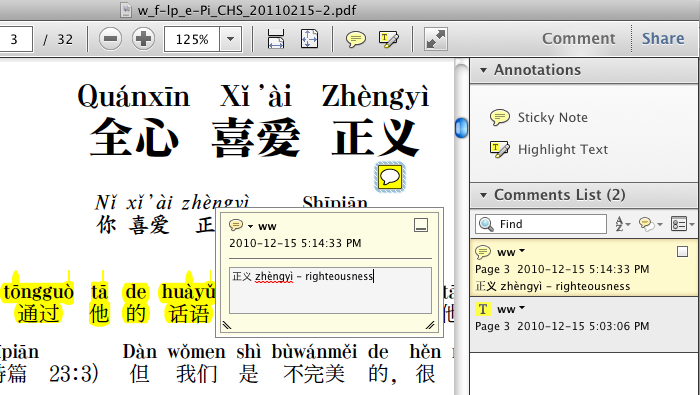
Other Annotation and Drawing Markup tools are also built in to Adobe Reader X, but they are only available for PDFs with the appropriate Reader Usage Rights enabled. Click here to go to a support page on Adobe’s website with more information on the Annotation and Drawing Markup tools available in Adobe Reader X.
In Adobe Reader 9, annotations are created using the Comment & Markup Toolbar, which is displayed (for annotation-enabled PDF files only) by right-clicking on an empty section of the toolbar area and selecting Comment & Markup from the resulting menu:
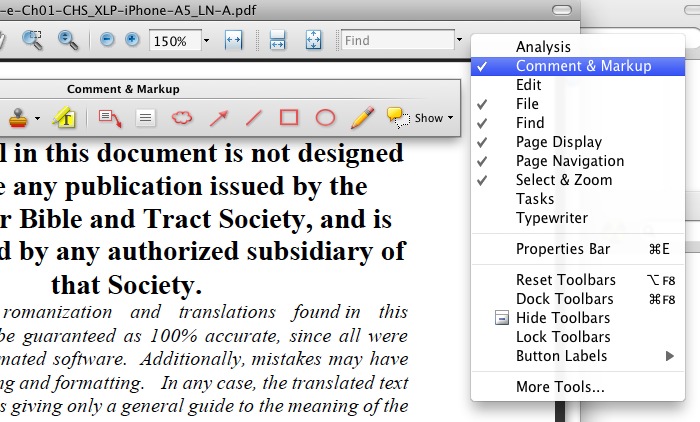
Alternately, the Comment & Markup Toolbar may also be displayed by going Tools | Comment & Markup | Show Comment & Markup Toolbar. Click here to go to a support page on Adobe’s website with more information on the tools available on the Comment & Markup Toolbar.
Note from the examples in the screenshot in the Introduction above that in Adobe Reader, annotation text properties such size, etc. can be set as desired. The Callout tool and the Text Box tool have more settable text properties than the other tools, including typeface and alignment.
After making some annotations to a PDF file, be sure to save it, or your annotations will be lost.
Unfortunately, versions of Adobe Reader older than Adobe Reader X can only add annotations to files that have been specifically enabled for commenting, such as the LN-A files. Thus, in those older versions of Adobe Reader, the Comment & Markup Toolbar will not be available on files that have not had commenting enabled.
PDF Annotation in Mac OS X’s Preview
In Mac OS X 10.6 Snow Leopard’s Preview application, annotations are created using the Annotations Toolbar, which is shown by clicking Annotate in the main toolbar:

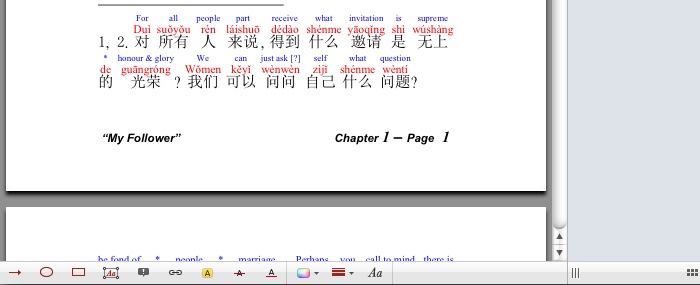
Alternately, Preview’s annotation tools may also be accessed by going Tools | Annotate | ... . The Annotations Toolbar appears at the bottom of the document window. Click here to go to a web page with more information on the tools available on the Annotations Toolbar.
After making some annotations to a PDF file, be sure to save it, or your annotations will be lost.
Note that Preview’s annotation tools do work in PDF files that have not been enabled for commenting like LN-A files have been. If a PDF has had comments explicitly not allowed in its security properties though, Preview cannot save any annotations to it. However, it can annotate that PDF and then save it as a new, separate file using the File | Save As... command if the necessary password is supplied.
PDF Annotation in PDF-XChange Viewer & Foxit Reader
PDF-XChange Viewer and Foxit Reader are two free Windows programs that allow annotation of PDF files, including those that have not been enabled for commenting like LN-A files have been. The official pinyin Watchtower PDF files currently available for download from jw.org are examples of such files that are not enabled for commenting in versions of Adobe Reader older than Adobe Reader X. Here are screenshots of annotations applied to a pinyin Watchtower PDF file downloaded from jw.org, using first PDF-XChange Viewer, and then Foxit Reader:
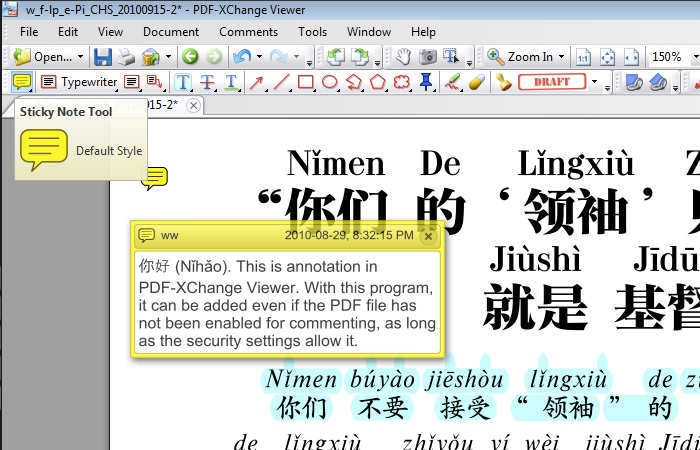
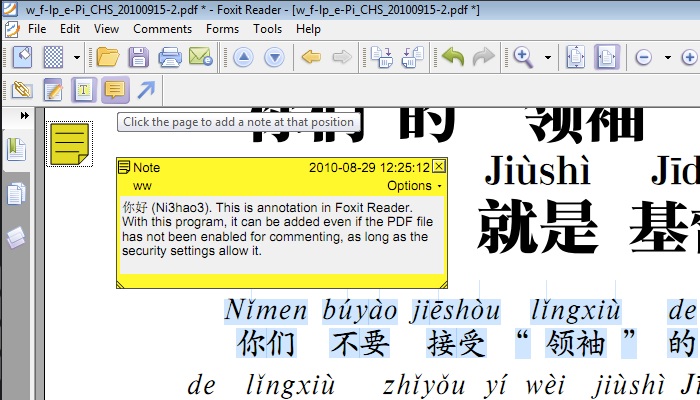
Note that while PDF-XChange Viewer allowed me to paste both Unicode Chinese characters and Unicode pinyin vowels into a note, Foxit Reader would not allow me to paste Unicode pinyin vowels into a note, requiring me to use numbers to represent pinyin tones.
After making some annotations to a PDF file in either of these programs, be sure to save the PDF file, or your annotations will be lost.
If a PDF file has had comments explicitly disallowed in its security properties, then neither PDF-XChange Viewer nor Foxit Reader will be able to add annotations to it. PDF-XChange Viewer allows one to change the security settings of a secured PDF file if the necessary password is supplied, but this feature is greyed out in Foxit Reader.
PDF Annotation in iPhone, iPod touch, and iPad Apps
Many iPhone/iPod touch/iPad PDF viewing apps now support annotation. E.g., here are the links for GoodReader and Documents:
Here are some screenshots of GoodReader, showing annotations applied to a Watchtower PDF downloaded from jw.org:
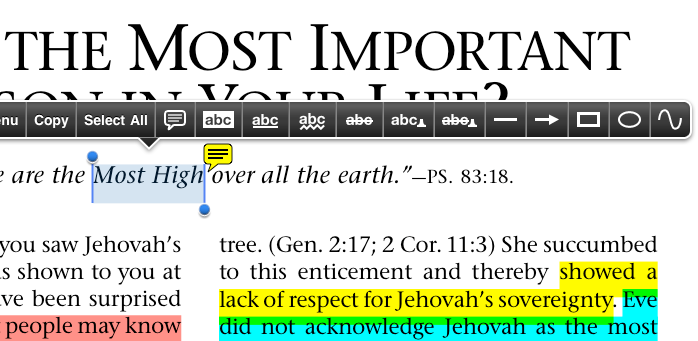
GoodReader - The menu that appears after you make a selection
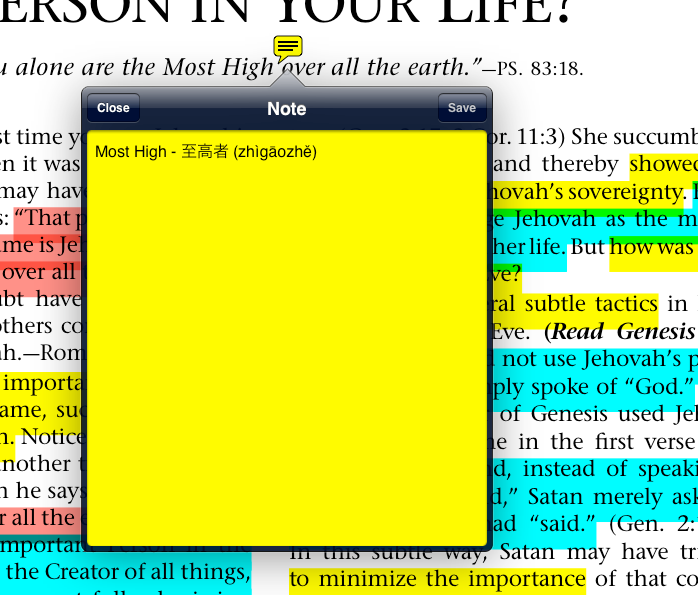
GoodReader - A note annotation, which can contain Chinese characters and pinyin. To quickly and easily type pinyin with proper diacritical tone marks on an iPhone, iPod touch, or iPad, you may use the app Pinyin Typist (official website). [Full disclosure: I am the creator of Pinyin Typist.]
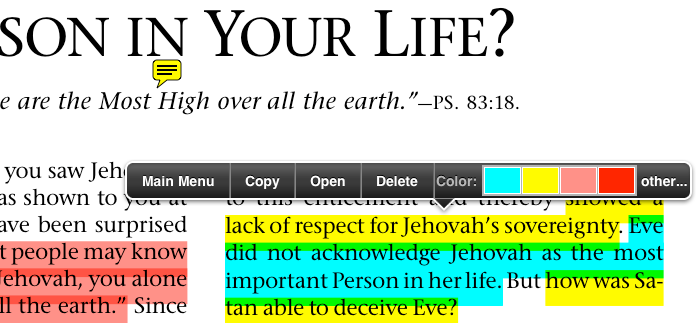
GoodReader - The menu that appears when you tap on an annotation
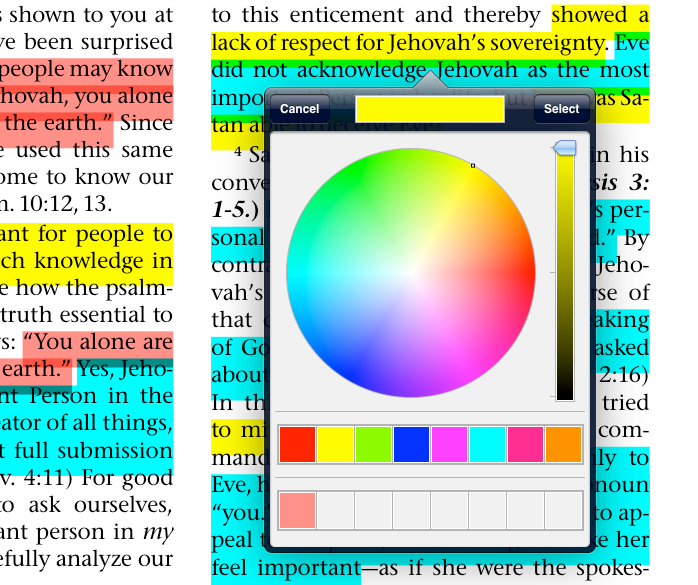
GoodReader - The dialogue box for setting the highlight colour
Annotations made to a PDF file in GoodReader on an iPhone, iPod touch, or an iPad are autosaved.
Here are a few other iPhone/iPod touch apps with at least some support for PDF annotation:
Here are some other iPad apps with at least some support for PDF annotation:
For more information on using 3-line material on the iPhone or iPod touch, see the 3-Line Material on the iPhone and the iPod touch page. For more information on using 3-line material on the iPad, see the 3-Line Material on the iPad page.